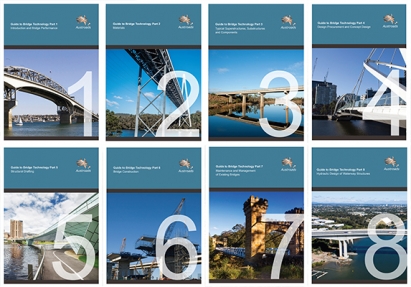Wednesday, 28 February 2018
Austroads has released an updated Guide to Bridge Technology to align with the recently revised AS 5100 and changes in industry practice.

The Guide provides a step-by-step approach to the planning process, building materials, bridge construction, learnings from the past, types of bridge designs and the management and ongoing maintenance of older bridge types.
Bridges in Australia and New Zealand are designed in accordance with AS 5100 (Bridge Design), and the NZ Transport Agency Bridge Manual. The Guide provides supporting information to the Standards, enabling users to apply and interpret them to achieve the best design, assessment, management and maintenance outcomes.
The Guide to Bridge Technology was first published in 2009 and a complete revision of this series has been undertaken, including the addition of a new Part which covers the hydraulic design of waterway structures.
The Guide now has eight parts:
- Part 1: Introduction and bridge performance
This Part covers the scope of the Guide to Bridge Technology, including factors affecting bridge performance, the relationship to the bridge design standards, and an understanding of the evolution of bridges and bridge loadings. - Part 2: Materials
The full range of bridge building materials is discussed in Part 2 including concrete, steel, timber and non-metallic components. It also discusses the material characteristics including the individual stress mechanisms. - Part 3: Typical bridge superstructures, substructures and components
Superstructure and substructure components –namely timber, steel, wrought iron, reinforced and pre-stressed concrete are discussed including typical bridge types such as suspension, cable stayed and arched types as well as bridge foundations. - Part 4: Design procurement and concept design
Bridge design process procurement models, specification requirements, design and delivery management processes, design checking and review concepts, the use of standardised components, aesthetics/architectural requirements, standard presentation of drawings and reports, designing for constructability and maintenance are covered. The service life of the structure and components, mining and subsidence, flood plains, bridge loadings, and geotechnical and environmental considerations are also discussed. - Part 5: Structural drafting
This Part covers the detailed drawing aspects required to clearly convey to the consultant/construction contractor the specifics of the project. It discusses the various Standards including details required for cost estimating and material quantities. Coverage also includes reinforcement identification details. - Part 6: Bridge construction
This Part provides guidance to the bridge owner's representative on site and focuses on bridge technology, high-risk construction processes e.g. piling, pre-stressing, and the relevant technical surveillance requirements during the construction phase. Bridge geometry, the management of existing road traffic and temporary works are also discussed in this Part. - Part 7: Maintenance and management of existing bridges
Maintenance issues for timber, reinforced and pre-stressed concrete, steel, wrought and cast-iron bridges are discussed. Other bridge components including bridge bearings and deck joints are also referred to. This Part also covers the monitoring, inspection and management of bridge conditions. - Part 8: Hydraulic Design of Waterway Structures
Guidelines for the hydraulic design of bridges, culverts and floodway is provided including design of new bridges for scour and monitoring and evaluation of scour at existing bridge sites.
Each part of the Guide can be purchased separately or all parts can be purchased as a set in hardcopy or PDF.
Austroads members can download PDF versions of the Guides for free. This includes all state and territory road agencies and local councils in Australia and New Zealand. To request your user login and password for free access please send an email from your work email address to austroads@austroads.com.au
Publication link: Guide to Bridge Technology
